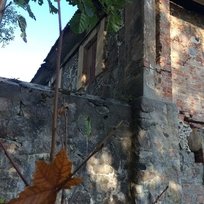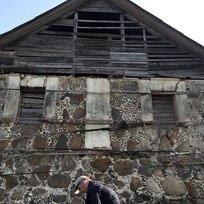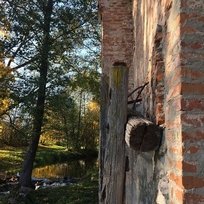The mill, once used for grinding grain, is currently abandoned in the village of Juodagalviai by the Kančiogina stream.
The black-headed mill belonged to the Benislavskis, the landowners of Krikonys, and it is mentioned in the inventory books of the estate as early as the 18th century. (1738 and 1750). The years of prosperity of the mill, its "golden age", were in the Polish era, during the time of the last owner of the tragic fate, Edvard Benislavski. He built a new, more efficient Polish turbine, installed two windmills instead of one. One used to grind only poor grain for animals, and the other used flour for bread and cakes. They milled flour and made gruce (pearl semolina). The new turbine also made better use of water power. The water was harnessed not only to turn the turbine, but also to work other auxiliary mechanisms, lifting bags to the top. From all the villages in the vicinity they brought ground grain, especially good grain. Two families lived in the mill next to Mr., later a Jew who was shot by the Germans during the war, after the war "bezants" (refugees) from Russia, it seems, lived with Oriol for a while. in 1838 for the debts goes to Stanevičiai and never again falls into the hands of Belikovići. The first decline of the mill was in 1939, when the Bolsheviks came and looted the manor and the mill, the second decline began already after the war, during the time of the collective farms. in 1944 after the Russians returned, the soldiers started throwing explosives into the mill pond, thus "fishing" the fish. The explosions also irreparably damaged the dam. After the establishment of the "Naujo kelos" collective farm, the mill broke down, was repaired, rotated intermittently, but still worked. After the dam was blown up, a diesel engine was built to turn the mills (later electric motors were installed).






Atsimenu, kolūkių laikais paskutinis malūninikas buvo toks Nikita Pavlov iš Joneliškių kaimo (dabar jau šio kaimo nebėra), 1977 m. jis kažkaip mįslingai žuvo netoli šio malūno...